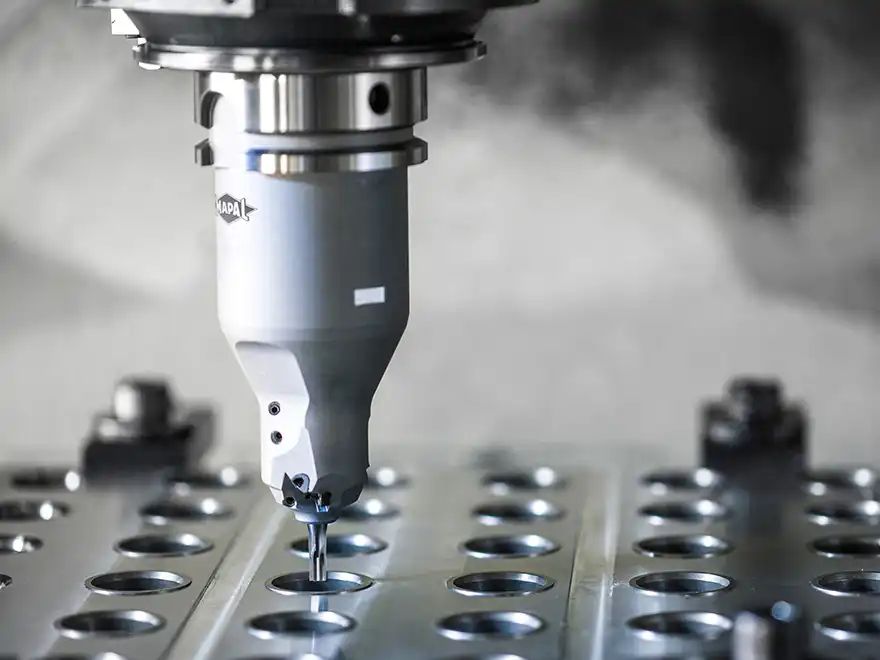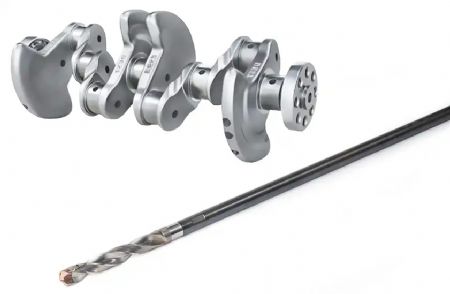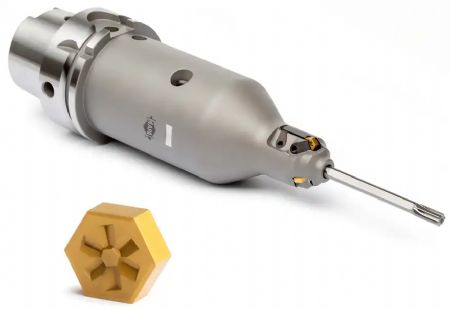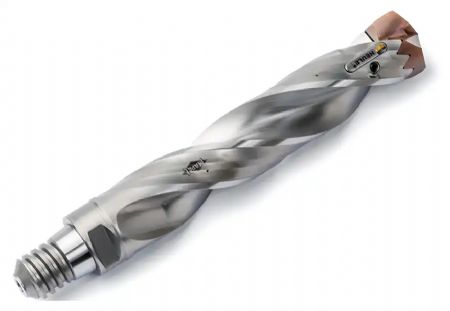 The doubling of the cutting edges, the use of PcBN high-performance cutting materials, and a robust clamping system result in a big increase in the productivity of valve seat machining. Photos: Mapal
The doubling of the cutting edges, the use of PcBN high-performance cutting materials, and a robust clamping system result in a big increase in the productivity of valve seat machining. Photos: Mapal Production figures for vehicles with combustion engines are in decline but are still very high, at around 75 million cars built each year — a compelling reason to continue seeking ways to optimise series production. Rugby-based
Mapal Ltd is lending its support to the cause with new tool solutions for modern combustion and hybrid engines. The automotive industry consistently prioritises reducing cycle times and minimising costs per part. Mapal shows how this can be achieved with two examples of crankshaft manufacturing and valve seat machining with the combination of processing steps and innovative tool technologies.
The desire to save weight, and therefore fuel, with less moving mass does not stop at a classic component like the crankshaft. To remove material, a central relief bore runs through the entire component. Due to the shape of the crankshaft, the tool repeatedly enters and exits the material during machining and the number of times depends on the number of cylinders in the engine.
 Pictured right: relief bores in crankshafts contribute to weight savings. In co-operation with Heule Precision Tools, Mapal now offers a tool that drills and deburrs the long bores in a single operation
Pictured right: relief bores in crankshafts contribute to weight savings. In co-operation with Heule Precision Tools, Mapal now offers a tool that drills and deburrs the long bores in a single operationThis also determines the length of the drill. To process the entire crankshaft in one go, tools with lengths between 600 and 800mm are required and Mapal achieves this with a modular system. The drill body is a special replaceable head holder with TTS (torque transfer system) connection that guarantees an extremely stable joint. The Mapal connection features optimal torque transmission and high changeover and radial run-out accuracies. For the desired tool length, the tool holder is screwed onto an extension. The TTD replaceable drill head at the tip is available in various geometric designs depending on machine performance.
‘One-shot solution’One challenge in machining is the burrs that occur in the metal when the drill goes in and out. While these burrs were previously removed in a separate machining step, Mapal now offers a ‘one-shot solution’ for simultaneous drilling and deburring. This is made possible by a modular combination tool in which an additional chamfer insert is integrated into the chamfer behind the drill head. This SNAP18 module is a miniaturised deburring system that has been individually designed by
Heule Precision Tools for the application. For reliable forward and reverse deburring, a small spring controls the insert and ensures the pre-drilled diameter is chamfered to the nearest 10th and is not damaged during deburring. This tool solution saves the user a step and a space for a tool in the magazine and so the cycle time is reduced.
 Pictured left: the HNHX indexable inserts have at least 12 cutting edges and thus raise the cost-effectiveness of valve seat machining to a new level
Pictured left: the HNHX indexable inserts have at least 12 cutting edges and thus raise the cost-effectiveness of valve seat machining to a new levelTo reduce costs in the fine machining of valve seats, Mapal has developed an innovative HNHX indexable insert. Like the predecessor model, the HNHX is also hexagonal, but 12 cutting edges can be inserted instead of six — the negative installation position enables this new indexable insert to be turned. A modified clamping star ensures maximum force closure and precise positioning in the insert seat. For the finishing of the valve seat ring, ultra-precise machining is required with regard to the specified tolerances and surface quality. With the HNHX, surface values of less than Ra 2.0 are achieved.
Mapal recommends a combination tool for machining the valve seat and valve guide. In one machining step, the tool first machines the valve guide and then the valve seat with the HNHX indexable insert.
Inserts can be used twiceDepending on the valve seat design, the HNHX indexable inserts can also be used more than 12 times. Where possible from a construction perspective, such as for larger valve seat rings in lorries, these inserts can be used twice, meaning 24 cutting edges can be used. This is done by removing the cutting edge at the end of its tool life and reusing it in a different angular position. The cutting edges used are easy for the user to identify thanks to a corresponding coating. This enables simple repositioning in another insert seat and further processing using an yet unused area of the cutting edge.
 Pictured right: this single-shot tool is used for machining the relief bore in crankshafts. It performs the drilling operation and the deburring of the bore entry and exit in one operation
Pictured right: this single-shot tool is used for machining the relief bore in crankshafts. It performs the drilling operation and the deburring of the bore entry and exit in one operationDoubling the number of cutting edges has a direct impact on the user’s production costs: — the costs per part are halved as a result. Tool life is also increased using PcBN high-performance cutting materials developed within the Mapal Group. Cutting materials are being customised to align with developments in the industry, enhancing the wear resistance of valve seat rings through the use of innovative materials. Furthermore, a robust clamping system results in maximum force closure and thus a homogeneous distribution of force in the insert seat.
Despite the clear trend towards e-mobility, the development of combustion engines continues. Not least for use in modern hybrid vehicles. Mapal is available as a technology partner and will contribute to further optimising customers’ production in the years ahead.